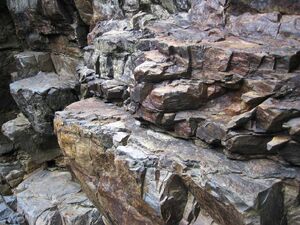
The rocky side of a mountain creek near Orosí, Costa Rica.

Sedimentary, volcanic, plutonic, metamorphic rock types of North America.
A rock is a naturally occurring aggregate of minerals and/or mineraloids. The Earth's crust (including the lithosphere) and mantle are formed of rock.
Petrology is the study of rocks.
Rock classification
Rocks are classified by mineral and chemical composition, by the texture of the constituent particles and by the processes that formed them. These indicators separate rocks into igneous, sedimentary and metamorphic. They may also be classified according to grain size, in the case of conglomerates and breccias or in the case of individual stones. The transformation of one rock type to another is described by the geological model called the rock cycle.
Igneous
Igneous rocks are formed from molten magma and are divided into two main categories: plutonic rock and volcanic. Plutonic or intrusive rocks result when magma cools and crystallises slowly within the Earth's crust, while volcanic or extrusive rocks result from magma reaching the surface either as lava or fragmental ejecta. Intrusive igneous rocks usually take a few thousand years to cool whereas extrusive igneous rocks take only a few days or weeks to cool and solidify.
Sedimentary
Sedimentary rocks are formed by deposition of either clastic sediments, organic matter, or chemical precipitates (evaporites), followed by compaction of the particulate matter and cementation during diagenesis. Sedimentary rocks form at or near the Earth's surface. Erosion carries sediments which eventually stack on top of each other. It cements together over time and forms sedimentary rock.
Metamorphic
Metamorphic rocks are formed by subjecting any rock type (including previously-formed metamorphic rock) to different temperature and pressure conditions than those in which the original rock was formed. These temperatures and pressures are always higher than those at the Earth's surface and must be sufficiently high so as to change the original minerals into other mineral types or else into other forms of the same minerals (e.g. by recrystallisation).
Classification caveat
The three great classes of rocks above enumerated — the igneous, the sedimentary and the metamorphic — are subdivided into many groups which to a small extent resemble the genera and species under which the naturalist classifies the members of the animal kingdom. There are, however, no hard and fast boundaries between allied rocks. By increase or diminution in the proportions of their constituent minerals they pass by every gradation into one another, the distinctive structures also of one kind of rock may often be traced gradually merging into those of another. Hence the definitions adopted in establishing rock nomenclature merely correspond to selected points (more or less arbitrary) in a continuously graduated series. This is frequently urged as a reason for reducing rock classification to its simplest possible terms, and using only a few generalized rock designations. But it is clear that may apparently trivial differences tend regularly to recur, and have a real significance, and so long as any variation can be shown to be of this nature it deserves recognition.[1]

A example of a metamorphic rock in Namadgi National Park
Coloration
Oxides and carbonates of iron play a large part in many sedimentary rocks and are especially important as coloring matters. The red sands and limestones, for example, which are so abundant, contain small amounts of ferric oxide (haematite), which in a finely divided state gives a red hue to all rocks in which it is present. Limonite and goethite, on the other hand, makes rocks yellow or brown; manganese oxides, asphalt and other carbonaceous substances are the cause of the black color of many sediments. Bluish tints result sometimes from the presence of phosphates or of fluorite; while green is most frequently seen in rocks which contain glauconite or chlorite.[1]
Impact on Society
Rocks have had a huge impact on the cultural and technological advancement of the human race. The mining of rocks for their metal ore content has been one of the most important factors of human advancement. Humanity's advancement has been decided by the kind of metals available from the rocks of a region. The prehistory of civilization is classified into the stone age, iron age, and bronze age. Rocks have been and continue to be used to construct buildings and infrastructure.
See also
- List of minerals
- List of rocks (geological)
- List of stone (building stone)
- Quarrying
- Formation of rocks
- Rock formations (a list of scenic features)
- Megalith (Archaeology)
- Riprap (civil engineering use)
- Geology
- Geomorphology